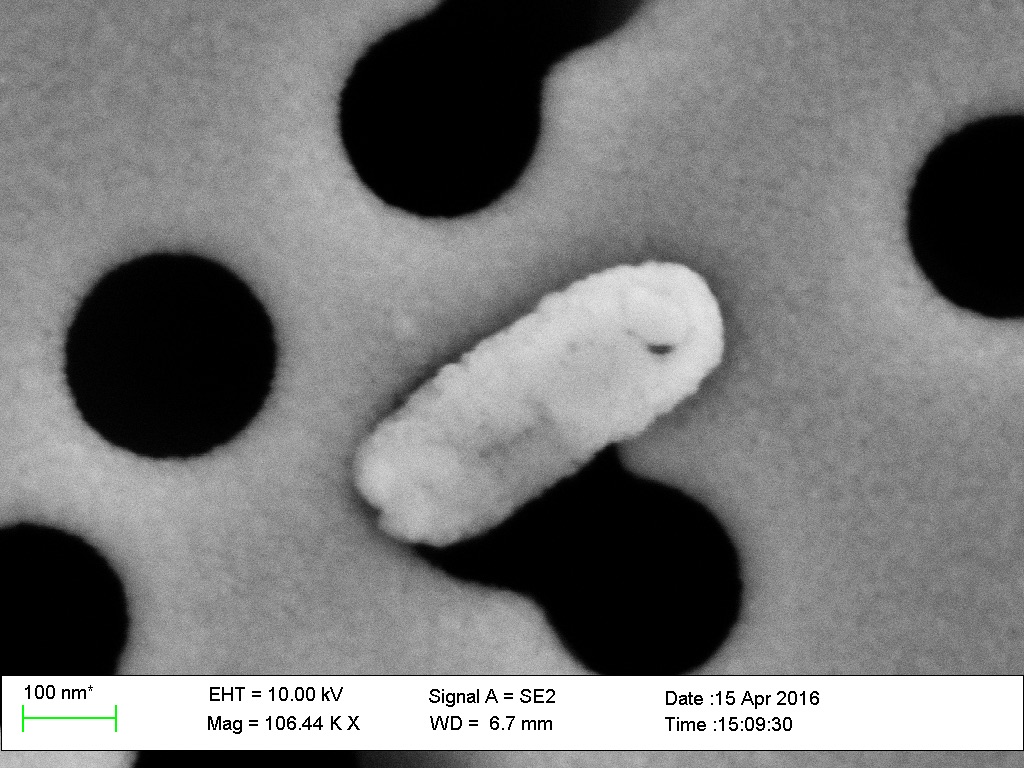-
Microbes Dine (Very Slowly) on Coal and Shale, 2 Km Beneath the Seafloor
November 01, 2017 / Posted by: Miki Huynh
A microbe collected from an incubation of coal amended with methylamine. Source: Trembath-Reichert et al. (via DCO)Elizabeth Trembath-Reichert. a NASA Postdoctoral Porgram fellow at the Woods Hole Oceanographic Institution and a member of the NASA Astrobiology Institute team based at the University of Southern California, is lead author on a paper that measures the activity level and generation times of microbes living in coal and shale beds up to two kilometers below the seafloor. Despite low cell numbers and slow reproduction, the microbes actively consume carbon and nitrogen compounds from their environment.
The paper, “Methyl-compound use and slow growth characterize microbial life in 2-km-deep subseafloor coal and shale beds” is published in Proceedings of the National Academy of Sciences. We excerpt a press release from Deep Carbon Observatory.
****
Scientists drill ever-deeper holes to discover the limits of subsurface life, but, so far, keep finding live microbes at the bottom. During Expedition 337 of the Integrated Ocean Drilling Program (IODP), the crew of the scientific drilling vessel Chikyu set a record for deepest scientific ocean drill hole, reaching 2,466 meters below the seafloor. New studies of microbes living in the coal and shale beds sampled on that trip reveal a slow but still active community eating these ancient buried carbon reserves.
Deep Carbon Observatory member Elizabeth Trembath-Reichert (Woods Hole Oceanographic Institution, USA), with Deep Life Community members Yuki Morono, Akira Ijiri, Tatsuhiko, Hoshino, Fumio Inagaki, (all at JAMSTEC, Japan), and Katherine Dawson and Victoria Orphan (both at California Institute of Technology, USA) measured the activity level and generation times of microbes living in coal and shale beds up to two kilometers below the seafloor. Despite low cell numbers and slow reproduction, the microbes were actively consuming carbon and nitrogen compounds from their environment. The researchers report their findings in a new paper in Proceedings of the National Academy of Sciences.
IODP targeted a location off the Shimokita Peninsula of Japan for drilling because the area had buried coal and shale deposits that might serve as energy reserves for deep microbes. These sediments date back to the Miocene era, and were deposited up to 20 million years ago. After collecting rock samples from between 1,600 to 2,000 meters below the seafloor, the researchers incubated pieces of coal and shale in culture bottles for more than two years.
To determine what kinds of metabolism the cells use and their activity levels, the researchers combined two techniques, stable isotope probing (SIP) and nanoscale secondary ion mass spectrometry (NanoSIMS). SIP allows researchers to trace biogeochemical cycles with isotopes, which are atoms of a chemical element that have a different number of neutrons in the nucleus, and NanoSIMS enables them to detect these isotopes within individual cells. The researchers spiked the cultures with isotope-labeled hydrogen through the incubation water, and different combinations of three carbon sources, methanol, methylamine, or ammonium, each of which contained a known amount of isotopes. After incubation, they analyzed individual cells with NanoSIMS to determine how rapidly each cell had consumed these compounds. Trembath-Reichert received a DCO Deep Life Cultivation internship to travel to JAMSTEC to prepare the incubations for NanoSIMS, which was critical for success, due to the extremely low cells numbers.
“This is the first deep biosphere study to apply highly sensitive, stable isotope tracers to analyze active microbial populations at the single-cell level,” said Trembath-Reichert. “This allows us to achieve more accurate per-cell rates of activity.”
The results of the NanoSIMS experiments suggest that deep microbes consumed the carbon compounds, but did so very slowly. The researchers estimate that the cells take several months to more than 100 years to produce new cellular material. These rates are faster than previous estimates of thousands of years, based on bulk analytical methods rather than individual cells. The cultures also revealed an incredible range in activity levels.
One surprising finding was that the cells primarily consumed the carbon compounds in the incubations using fermentation, rather than generating energy through methanogenesis, a metabolic process where microbes make methane from compounds with methyl groups, or using hydrogen and carbon dioxide. The researchers had expected it would be a viable lifestyle in this environment.
“It is still an interesting mystery to determine why methanogens aren’t more abundant and competitive in a system that should be replete in hydrogen and carbon dioxide,” said Trembath-Reichert.
Read the full story at the Deep Carbon Observatory website.
Source: [PNAS]
- The NASA Astrobiology Institute Concludes Its 20-year Tenure
- Global Geomorphologic Map of Titan
- Molecular Cousins Discovered on Titan
- Interdisciplinary Consortia for Astrobiology Research (ICAR)
- The NASA Astrobiology Science Forum Talks Now on YouTube
- The NASA Astrobiology Science Forum: The Origin, Evolution, Distribution and Future of Astrobiology
- Alternative Earths
- Drilling for Rock-Powered Life
- Imagining a Living Universe
- Workshops Without Walls: Astrovirology